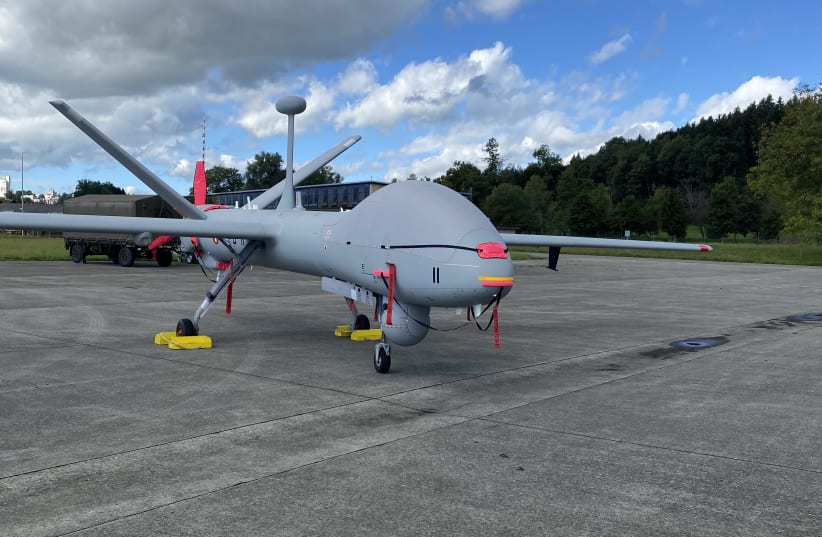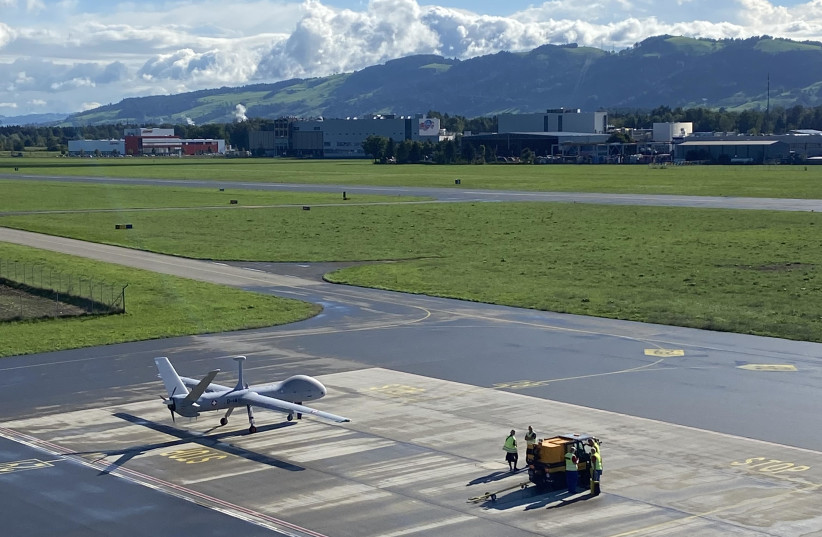EMMEN, Switzerland – The Swiss Air Force is looking toward future threats with its new fleet of Hermes Starliner unmanned aerial vehicles (UAVs) manufactured by Israel’s Elbit Systems.
The six UAVs will be based out of Emmen Air Base near the city of Lucerne and the fleet will be fully operational by the end of 2023.
The Starliner has a wingspan of 17 meters (56 feet), and weighs 1.6 tons. The unarmed reconnaissance system can carry an additional 450 kg. (992 lbs.)of electro-optical, thermal, radar and other payloads should additional ones be required. It has a maximum flight capability of 24 hours of continuous flight at a maximum speed of 260 kph (162 mph).
Switzerland bought the six UAVs, known in Switzerland as ADS-15, in a deal worth some $290 million in 2015 to replace the Ranger ADS-95 that were decommissioned after 20 years of service.
Though the systems will be mainly used for situation and target intelligence gathering, the deal garnered a lot of controversy in Switzerland.
Though Swiss law prohibits arming drones with air-to-ground missiles, Col. Walser from Switzerland’s Joint Forces Command told reporters that the military would not exclude the idea.
Walser said the drones were purchased not only for future conflicts, but also for reconnaissance missions that would support ground forces and border forces including dealing with illegal infiltrations into the country.
The Swiss Air Force aims to have two drones in the air at all times.
Where were the first few pilots trained?
The first 12 drone pilots (drones are piloted remotely) trained in Israel near Masada in December of last year. In April, the first two platforms along with ground control systems were delivered. The Swiss military carried out its first successful flight test of the drone in June. Additional harsh-weather winter condition tests will take place in northern Canada later this year.
The system was certified in February to be able to fly in civilian airspace, a key requirement placed on Elbit by Bern.
In order to meet certification standards, Elbit Systems had to install a host of civil aviation technological capabilities on the Hermes Starliner UAV, including a terrain avoidance warning system; automatic take-off and landing in harsh visibility; redundant avionics, sensors and satellite data links; plus adverse weather capabilities and direct lightning strike sustainment.
The approval to fly in any civilian airspace, including in populated areas, allows governments and organizations to use the system in various missions such as border security, anti-terrorism operations, securing mass public events, maritime search and rescue, agricultural work, environmental inspection missions and more.
The design and manufacture of the UAV was supervised by the Civil Aviation Authority of Israel. That also led to a rigorous six-year certification process that included extensive ground and test flights that were carried out in compliance with air navigation rules, airworthiness basis and aviation standards regulated by the International Civil Aviation Organization.
AS RUSSIA continues in its war in Ukraine, many European countries are modernizing their militaries to face future threats. Other than Switzerland and Canada, which bought the Starliner, countries like Finland and Denmark have also shown interest in the platform, as it can be integrated into civilian airspace and carry the necessary low-altitude intelligence, surveillance and reconnaissance (ISR) payloads.
In 2020, Canada bought a Hermes 900 to take part in missions in Canada’s Arctic. The drone is expected to be delivered by the end of the year and will join the National Aerial Surveillance Program to help with search and rescue, humanitarian efforts, illegal fishing enforcement and more.
According to Omri Knoller, the head of the program at Elbit, the maturity of the company’s family of drones and the capability to fly in civilian airspace is a key selling point of the Starliner.
“Not many European countries have UAVs that can fly in civil airspace,” he told The Jerusalem Post. “They have a solution now that they haven’t had before.”
The ability to fly in civil airspace “can provide solutions for anything-both military and civil,” he continued. “The Swiss weather conditions, mountain environment, which is similar to many other countries in Europe, may make this an interesting system for other countries as well.”
Israel is considered a leading exporter of drones, with defense companies selling these systems to militaries across the world.
The tense geopolitical situation in Europe is a major reason behind the expected purchasing spree. Countries around the world have been modernizing their forces to face new threats by purchasing systems such as UAVs from Israel.
Drones, like the Turkish-manufactured Bayraktar combat drone, continue to play a key role in Ukraine taking out countless Russian platforms. Drones also played a central role in the war between Armenia and Azerbaijan in the Nagorno-Karabakh war of last year.
Even before Russia invaded Ukraine in February, arms sales to Europe jumped compared to the previous five-year period, the Stockholm Peace Research Institute found in a recent report.
While global trade in major arms declined by 4.6%, according to the report, imports of major arms by European states were 19% higher from 2017 to 2021 than from 2012 to 2016, and accounted for 13% of global arms transfers.
Israel has already sold billions of dollars’ worth of weapons systems to Eastern European countries fearing Russian aggression since it annexed the Crimean Peninsula in 2014. In 2021, Israel’s defense exports reached $8.3 billion, with 30% of sales to Europe.
The sales included missiles, rockets, air-defense systems, communication, drones, intelligence systems, radar and early warning systems, ammunition and armament, manned aircraft, avionics, observation and optronics.
Systems such as precision-guided missiles, air-defense systems, unmanned aerial vehicles, and communication systems that have been hitting the Russian military will be on the shopping list of European countries that are modernizing their militaries against modern threats.
The writer was a guest of Elbit Systems.

